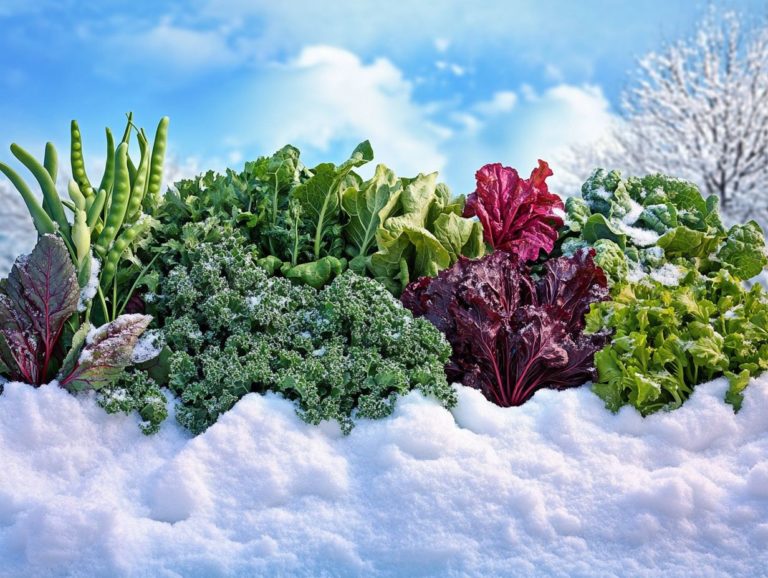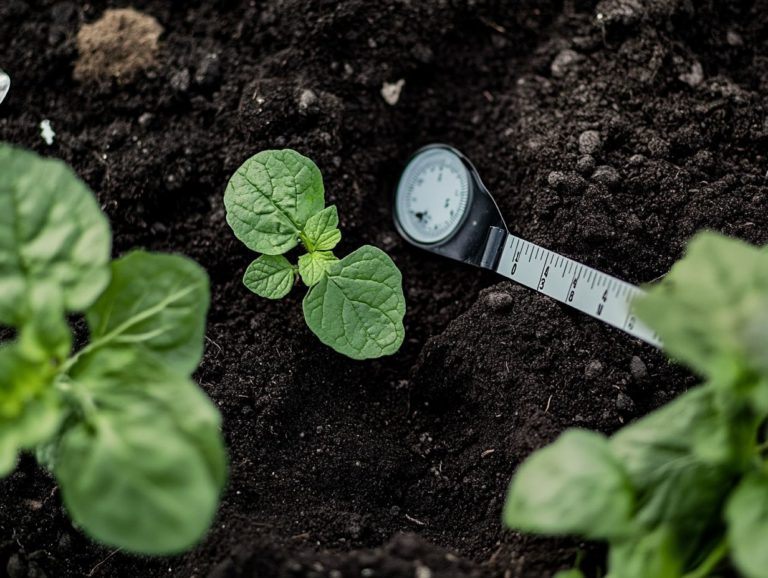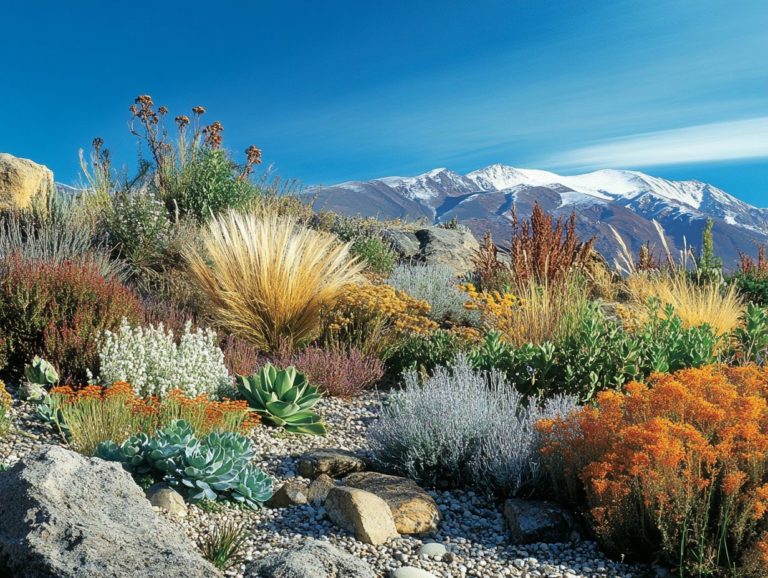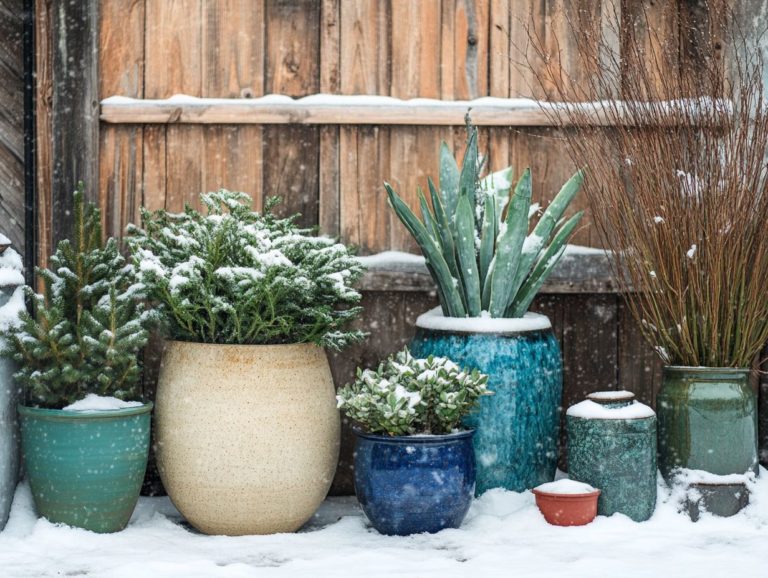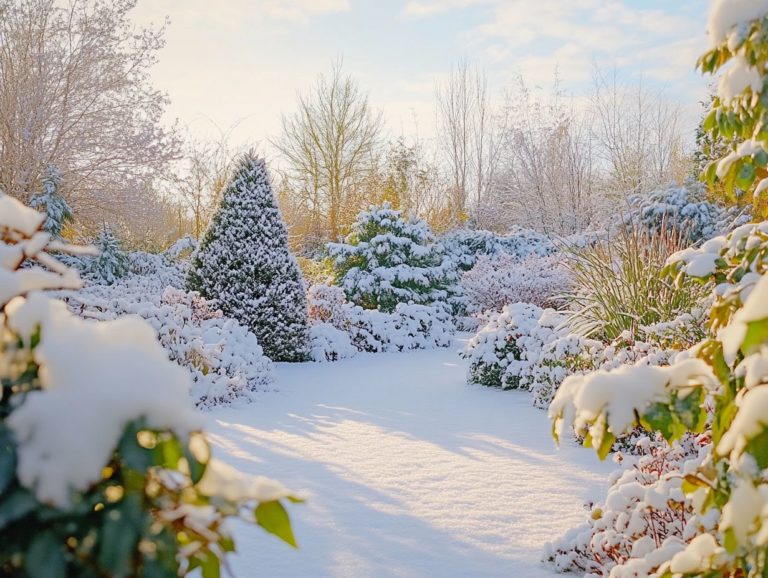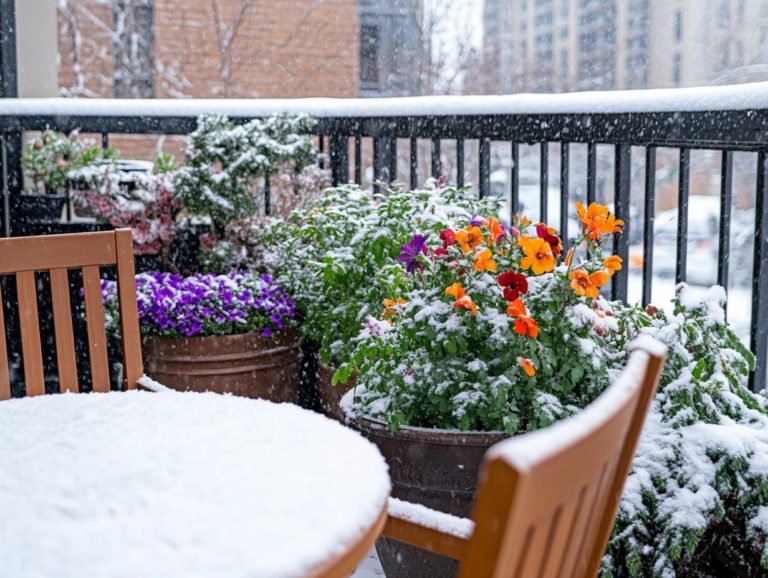Choosing a Variety of Cold-Climate Vegetables
Cold-climate vegetables are not merely resilient; they provide an array of benefits for both your health and the environment.
This article delves into the nutritional advantages and ecological impact of these hardy plants. You ll uncover essential factors to consider when selecting the right varieties for your garden, including climate compatibility and your personal preferences.
Prepare to gather practical tips for successful cultivation and discover popular varieties. You will also receive expert advice on harvesting and storing your abundant yields.
Embrace the joys of growing your own cold-climate vegetables, and relish the satisfaction that comes with nurturing your own garden!
Contents
- Key Takeaways:
- What are Cold-Climate Vegetables?
- Benefits of Growing Cold-Climate Vegetables
- Factors to Consider When Choosing Cold-Climate Vegetables
- How to Grow Cold-Climate Vegetables
- Popular Varieties of Cold-Climate Vegetables
- Harvesting and Storing Cold-Climate Vegetables
- Frequently Asked Questions
- What is the importance of choosing a variety of cold-climate vegetables?
- What factors should I consider when selecting cold-climate vegetables?
- Can I grow any type of vegetable in a cold-climate region?
- How can I ensure that my chosen cold-climate vegetables will be successful in my garden?
- Are there any cold-climate vegetables that are better suited for beginner gardeners?
- Can I extend the growing season for my cold-climate vegetables?
Key Takeaways:
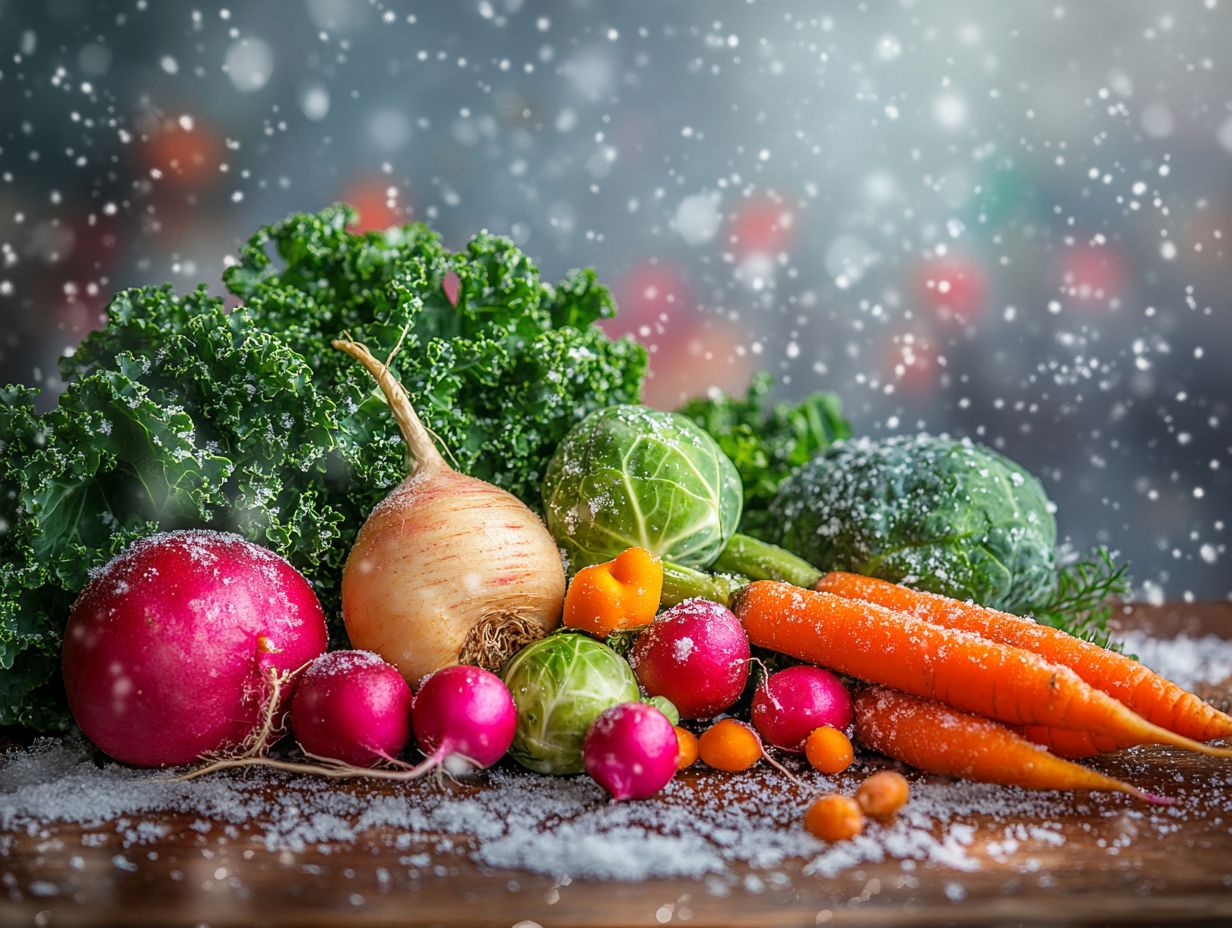
- Cold-climate vegetables offer numerous nutritional benefits and have a lower environmental impact than other varieties, making them ideal for winter gardening.
- When choosing cold-climate vegetables, consider your climate, growing conditions, personal preferences, and dietary needs.
- To successfully grow and harvest cold-climate vegetables, follow best practices and proper techniques, and store them using recommended preservation methods.
What are Cold-Climate Vegetables?
Cold-climate vegetables are your best friends when it comes to gardening in lower temperatures, as they allow you to extend your growing season well beyond those fleeting warm months. For inspiration, check out the top 10 winter vegetables for cold climates.
Think of broccoli, cabbage, spinach, peas, and carrots. These frost-tolerant varieties are not just resilient; they’re also your ticket to crafting healthy meals that impress at the dinner table.
To maximize your success, understanding their unique characteristics is key. These vegetables thrive in well-drained soil with adequate moisture. They have specific planting windows in both spring and fall that you won t want to miss.
While they bask in full sun, they re also tough enough to handle the brisk embrace of early morning frosts. When you plant them in nutrient-rich, loamy soil that’s been enriched with organic matter, you’re setting yourself up for bountiful yields.
Aim for a pH level between 6.0 and 7.0 to ensure they have access to all the nutrients they need.
Don’t overlook the benefits of crop rotation changing what you grow in a specific spot each year to improve soil health and companion planting; these strategies can significantly boost productivity.
These cold-climate varieties also enhance soil health and promote biodiversity, making them a savvy choice for anyone looking into choosing the right plants for cold climates, whether you’re a seasoned pro or just starting out.
Benefits of Growing Cold-Climate Vegetables
Growing cold-climate vegetables presents a wealth of advantages, from heightened nutritional value to beneficial environmental impacts. For more effective gardening, consider selecting plants for cold climate community gardens, as they are an essential component of your gardening repertoire.
These veggies are bursting with nutrients and promote sustainable gardening practices. By cultivating them, you can enjoy organic produce while nurturing the environment at the same time, practicing effective pest control strategies.
Nutritional Value and Environmental Impact
Cold-climate vegetables like kale, broccoli, and spinach are brimming with essential nutrients that elevate your health and well-being. These greens are not just a trend; they are a vital part of a balanced diet.
Their ability to thrive in cooler temperatures means you can often skip the synthetic pesticides and fertilizers, which is a win for sustainable farming.
These powerhouse veggies are loaded with vitamins A, C, and K, as well as minerals like iron and calcium. All of these support your immune system, strengthen your bones, and promote radiant skin.
By incorporating these leafy greens into your meals, you can enhance dietary diversity. Enjoy a delightful mix of flavors and textures while boosting your nutrient intake.
Opting for organic methods to grow these vegetables not only improves soil health and biodiversity but also significantly reduces the carbon footprint linked to conventional farming practices. This sustainable approach benefits not just your personal health but also contributes to environmental preservation, paving the way for a greener future for generations to come.
Don’t miss out on the chance to enjoy these amazing benefits! Start your own cold-climate vegetable garden today!
Factors to Consider When Choosing Cold-Climate Vegetables
When choosing cold-climate vegetables for your vegetable garden, consider several key factors: climate compatibility, specific growing conditions, and your cooking preferences. Additionally, choosing the right varieties for winter crops can greatly enhance your gardening success.
Understanding these elements helps you select the varieties that will thrive in your environment and cater to your dietary needs.
Climate and Growing Conditions
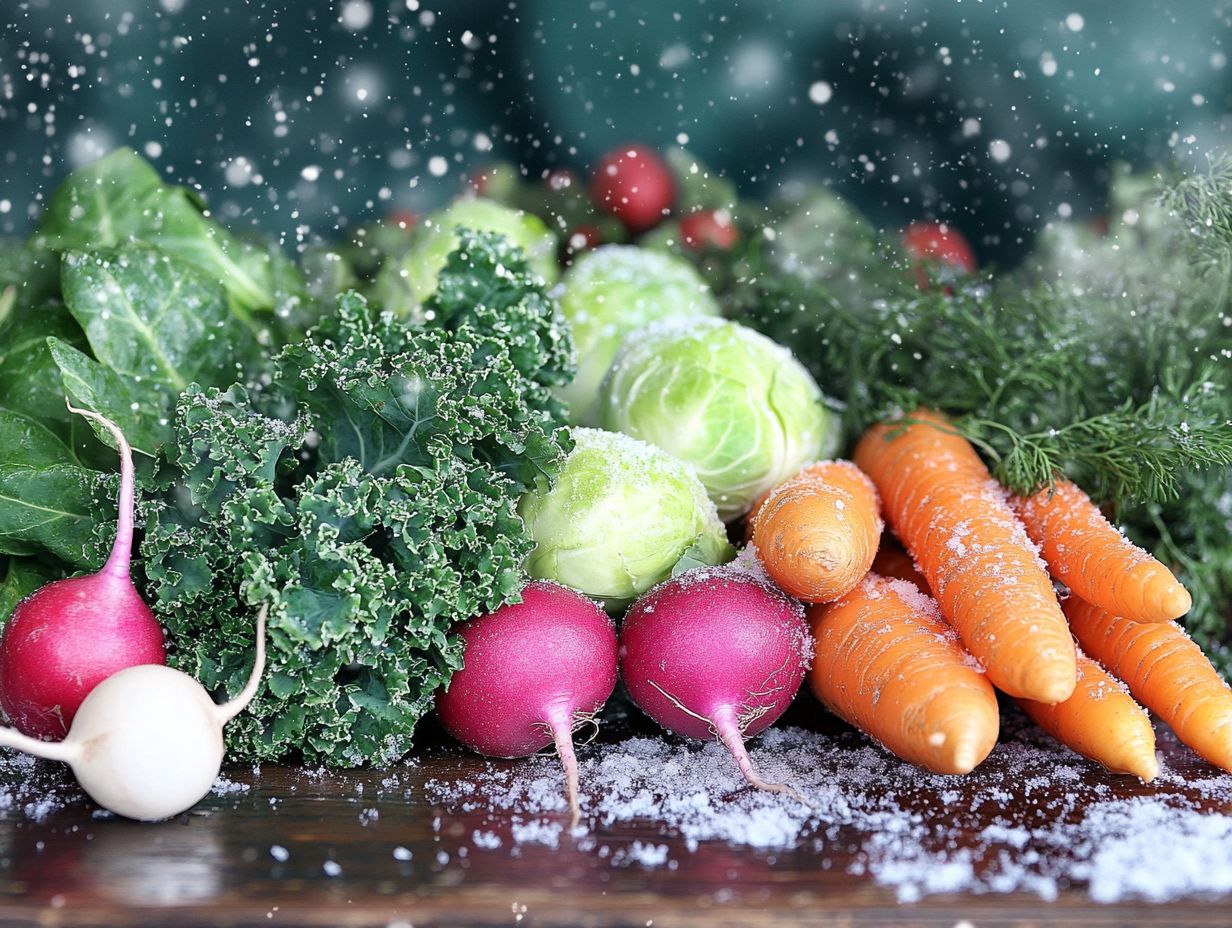
The climate and growing conditions are crucial to your success with cold-climate vegetables. Factors like temperature, soil type, and moisture levels significantly impact their growth potential.
For example, well-drained soil prevents root rot. Maintaining the right moisture levels guarantees optimal germination and the health of crops like leeks and radishes.
To cultivate a thriving garden brimming with these resilient varieties, pay close attention to seasonal adjustments. Prepare the soil by mixing in organic materials to enhance nutrient content and structure.
Implement a moisture management strategy by thinking of regular watering and mulching. This will help maintain consistent humidity levels, essential for the delicate root systems of crops that tolerate cold.
By understanding the unique needs of each vegetable and tailoring your planting schedules, you can ensure a bountiful harvest, even in less-than-ideal climates.
Personal Preferences and Dietary Needs
Let your personal preferences and dietary needs guide your choices when selecting cold-climate vegetables. For more insights, check out how to choose the right winter vegetables. This ensures the crops align with your cooking style and health objectives.
Consider incorporating varieties like kale, collards, and herbs like parsley to enhance the flavors and nutritional value of your meals.
If your family embraces organic eating, lean toward heirloom varieties or those known for their higher nutrient density. If you re dealing with gluten sensitivities, plant vegetables like zucchini or squash; they make fantastic substitutes for traditional grains.
Don t overlook culinary herbs like basil or cilantro. These can truly elevate the taste and healthfulness of your meals, making their inclusion essential.
By tailoring your garden to reflect these preferences, you create satisfaction at the dinner table and cultivate a deeper connection to the food you grow.
How to Grow Cold-Climate Vegetables
To successfully cultivate cold-climate vegetables, embrace specific practices that enhance crop yield. This includes mastering proper planting techniques, providing adequate care, and paying close attention to seasonal timing.
By employing these strategies, you can ensure that vegetables like broccoli, carrots, and spinach not only survive but truly thrive in cooler conditions.
Best Practices and Tips
Implementing best practices for growing cold-climate vegetables can significantly elevate your gardening success. Consider timing your planting with seasonal conditions and mastering proper watering techniques.
These approaches promote healthy growth and enhance your crop yields, particularly for vegetables like fava beans and leeks.
Understanding the unique challenges colder temperatures present is essential. Keep an eye on the last frost dates in spring and the first frost dates in fall to optimize your planting schedule.
Maintaining consistent moisture levels is vital; aim to keep the soil evenly moist without waterlogging it. Mulching can help retain soil moisture and regulate temperature.
By incorporating these practices, you create an environment where cold-climate vegetables can truly thrive, leading to bountiful harvests of crops.
Start your own cold-climate vegetable garden today and enjoy the fruits of your labor!
Popular Varieties of Cold-Climate Vegetables
You’ll find a remarkable selection of popular cold-climate vegetables. Each variety brings distinct flavors and culinary possibilities, making choosing the best plant varieties for cold climates essential in gardens throughout various regions.
Varieties like broccoli, kale, and Brussels sprouts not only enrich your meal options, but they also thrive beautifully in cooler temperatures. This makes them excellent choices for container gardening.
Descriptions and Recommended Uses
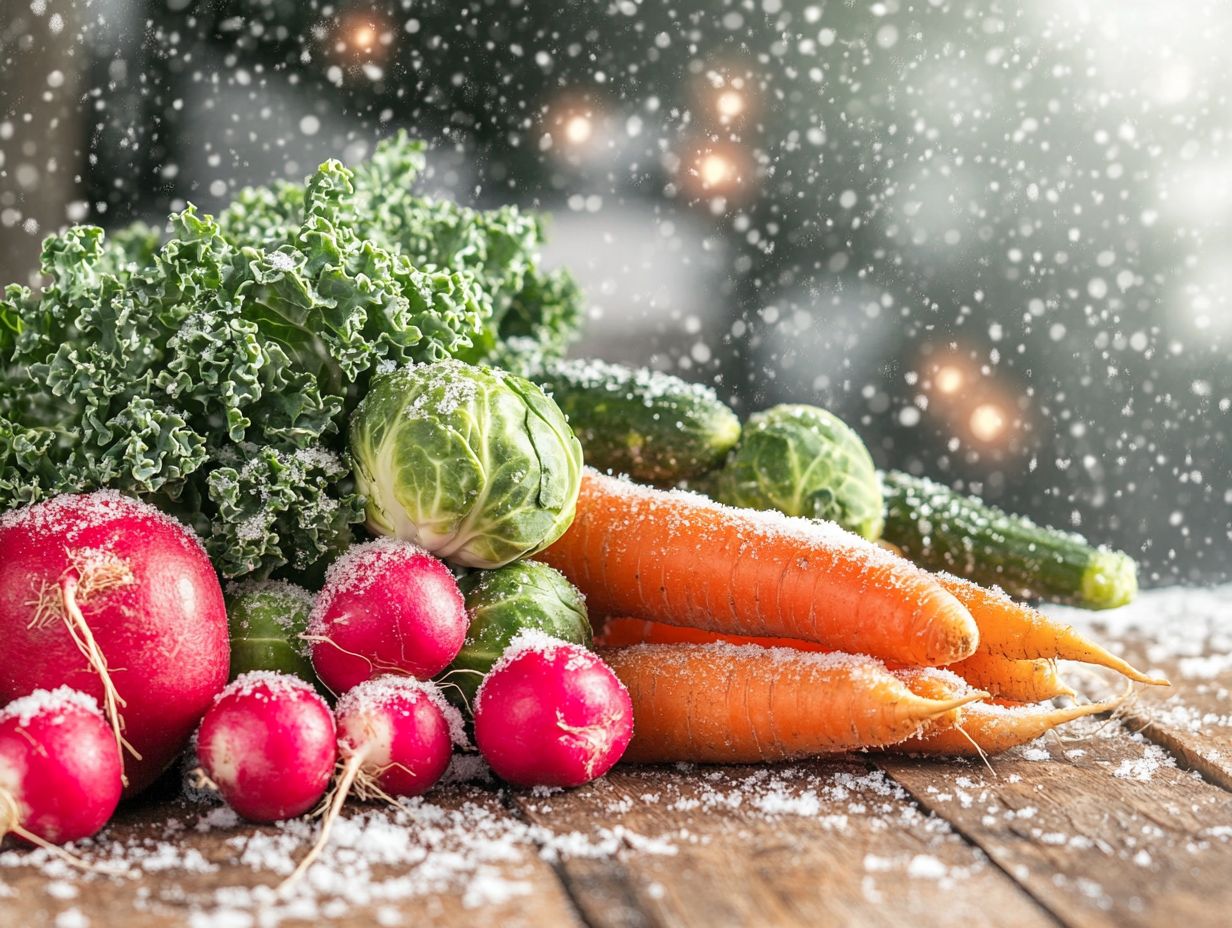
Descriptions and recommended uses for cold-climate vegetables like broccoli, carrots, and kale can significantly enhance your gardening choices. Take broccoli, for instance. It s a nutrient powerhouse packed with vitamins and minerals, shining in everything from stir-fries to comforting soups.
Carrots, with their sweet, earthy flavor, thrive in cooler soils and come in various colors. Each color adds visual appeal and nutritional benefits to your meals. They are ideal for roasting or simmering in stews, and they also bring a delightful crunch to salads.
Kale is another standout. This hearty green brims with vitamins and is perfect for saut ing or massaging into salads. It s a staple in health-conscious kitchens. These vibrant vegetables burst with flavors and textures. They invite you to explore creative culinary uses, whether you re blending them into smoothies or roasting them to golden perfection.
By understanding their individual growth requirements, you can cultivate a bountiful harvest tailored for a multitude of delicious dishes.
Harvesting and Storing Cold-Climate Vegetables
Harvesting and storing cold-climate vegetables demands particular techniques. This maintains their freshness and maximizes shelf life, an essential aspect of preserving the nutritional benefits of crops such as spinach and fava beans.
Use the right harvesting methods to ensure your vegetables retain their flavor and nutritional value. This also extends their usability for your culinary endeavors.
Essential Techniques to Preserve Your Vegetables Freshness
To maintain the quality and nutritional value of harvested cold-climate vegetables over time, use careful handling and appropriate storage solutions. This ensures that varieties like kale and onions remain fresh for extended periods.
Harvest during the cooler parts of the day to minimize stress on the vegetables, reducing the risk of spoilage. After harvesting those leafy greens, gently rinse them and store them in breathable containers to maintain humidity while preventing rot.
For root vegetables like carrots, place them in moist sand or peat to create optimal conditions. Humidity levels around 90-95% are crucial.
Onions thrive in well-ventilated, cool areas to prevent sprouting. By understanding these essential factors, you can significantly enhance the longevity and flavor of your prized cold-climate produce.
Frequently Asked Questions
What is the importance of choosing a variety of cold-climate vegetables?
Choosing different cold-climate vegetables means you’ll have a delicious and healthy variety on your plate! To learn more about which options are best, check out what vegetables grow best in cold climates. It ensures a diverse and nutritious diet, along with increased crop resilience against changing weather patterns.
What factors should I consider when selecting cold-climate vegetables?

Consider the temperature range of your region, the length of your growing season, and the specific needs of each vegetable variety.
Can I grow any type of vegetable in a cold-climate region?
Yes! Many varieties thrive in colder climates, including root vegetables, leafy greens, and certain types of cruciferous vegetables.
How can I ensure that my chosen cold-climate vegetables will be successful in my garden?
Follow proper planting and care instructions for each vegetable variety. Also, provide adequate protection from frost and extreme temperatures.
Start planting your cold-climate vegetables today for a bountiful harvest!
Are there any cold-climate vegetables that are better suited for beginner gardeners?
Some easy-to-grow cold-climate vegetables include radishes, lettuce, and kale. If you’re interested in maximizing your harvest, check out this guide on how to plan a cold-climate vegetable garden. They are low-maintenance and thrive in cooler temperatures.
Can I extend the growing season for my cold-climate vegetables?
You can extend the growing season using methods like row covers, cold frames, or hoop houses. These tools protect against frost and add warmth for your plants.

